How, When, And Why Diamond-Set Watches For Men Were Commonly Accepted And The Importance America Played
by Martin Green
“What are you in now?”
“I have a Dodge.”
“Those are wonderful if you want to get somewhere. This is for when you’ve already arrived.”
This exchange took place between Don Draper (main character of the television show “Mad Men”) and a Cadillac salesman.
However, this exchange could very well have been between a jeweler and a man like Draper discussing the possible purchase of a diamond-set watch – and not for his wife, but for himself.
Post-war United States boasted unique market conditions that allowed for diamond-set men’s watches to thrive. Though the majority of the world was still dealing with the aftermath of World War II, licking its wounds, and trying to rebuild what had been lost, the United States didn’t see action on its native soil other than the attack on Pearl Harbor.
With infrastructure intact and armed forces returning home, the country was on the verge of a time in which rapid developments went hand in hand with growing prosperity. Men treated themselves with diamond-set watches as an expression of the freedom and prosperity they fought so hard to maintain.
And not so much in the spirit of flaunting, but as a personal reward for their achievement – one that, in the American culture, also doubled as an inspiration for others to pursue such achievements themselves.
In essence, diamond-set watches became part of the American Dream.
Diamond-set men’s watches: common and accepted
Yet this was only part of the unique circumstances under which diamond-set men’s watches flourished in America.
High import taxes on finished watches forced most watch brands to open subsidiaries in the United States, which obtained their movements from the manufactures located in Switzerland, but enjoyed considerable freedom to create watches that would appeal to the American public.
The fact that this also meant that cases, crowns, and crystals had to be sourced in the United States was not a problem in post-war America since at that time the country still had a considerable watch industry of its own with many of those existing suppliers also taking care of the needs of the Swiss brands.
This resulted in a wristwatch subculture, with the diamond-set examples positioned right at the top.
Before I continue, it is important to know that although diamond-set men’s watches were common and accepted in those days, it doesn’t mean that they were all that were visible. Most brands offered multiple bejeweled models for men, and many jewelers carried them as a regular part of their inventories. These diamond-set men’s watches were at the top of the food chain, and even in prosperous America not affordable for the majority.
Also, many watch brands had different positioning in the marketplace than they do now. Longines was a major player in those days, yet it was not the same Longines we know today. The brand’s watches – not to mention its movements – were so refined that they can best be compared with Jaeger-LeCoultre and perhaps even Patek Philippe.

A 14-karat white gold diamond-set vintage Hamilton in a rectangular case (photo courtesy George Cramer)
The same could be said about Hamilton, which was still a force to be reckoned with in its native marketplace, quite unlike the brand’s current positioning. It is important to understand this as the knowledge is necessary to put the diamond-set watches such as those shown in this article in the right perspective, and to be able to enjoy them for what they truly are.
A dual-culture diamond-set man’s watch: LeCoultre Galaxy
As popular as they once were, the fate of men’s diamond-set watches is rather tragic.
Like so many mechanical timepieces, diamond-set men’s watches suffered through the Quartz Crisis. However, they did not only lose their future, but also their past.
The shock wave sent by the introduction of inexpensive, reliable, and accurate Japanese quartz watches devastated the watch industry. It ripped the American watch industry as good as entirely away and left its Swiss counterpart hanging by a thread.
Many subsidiaries were abolished and their records vanished. Since the Swiss records were preserved, most brands are able to provide a customer with the day and date that the movement of a diamond-set men’s watch was shipped off to the subsidiary. However, in most cases no records exist pertaining to what happened after that.
With that, American diamond-set watches lost their past. And when many watch brands emerged on the other side of the quartz crisis, it turned out that they had also lost their futures.
The world had become a far more global marketplace, and the once-secluded American market no longer existed as such. Nor did the taste that made these watches once so popular.
One watch that embodies the mystery of Swiss lineage with American taste of this period is the LeCoultre Galaxy.
Of course, this is somewhat ironic since this timepiece is actually what’s known as a mystery watch. But what is even more a mystery than how it tells time can be found on the back of the watch: here, in curly hand-engraved letters, one not only finds the LeCoultre name, but also the Vacheron Constantin name.
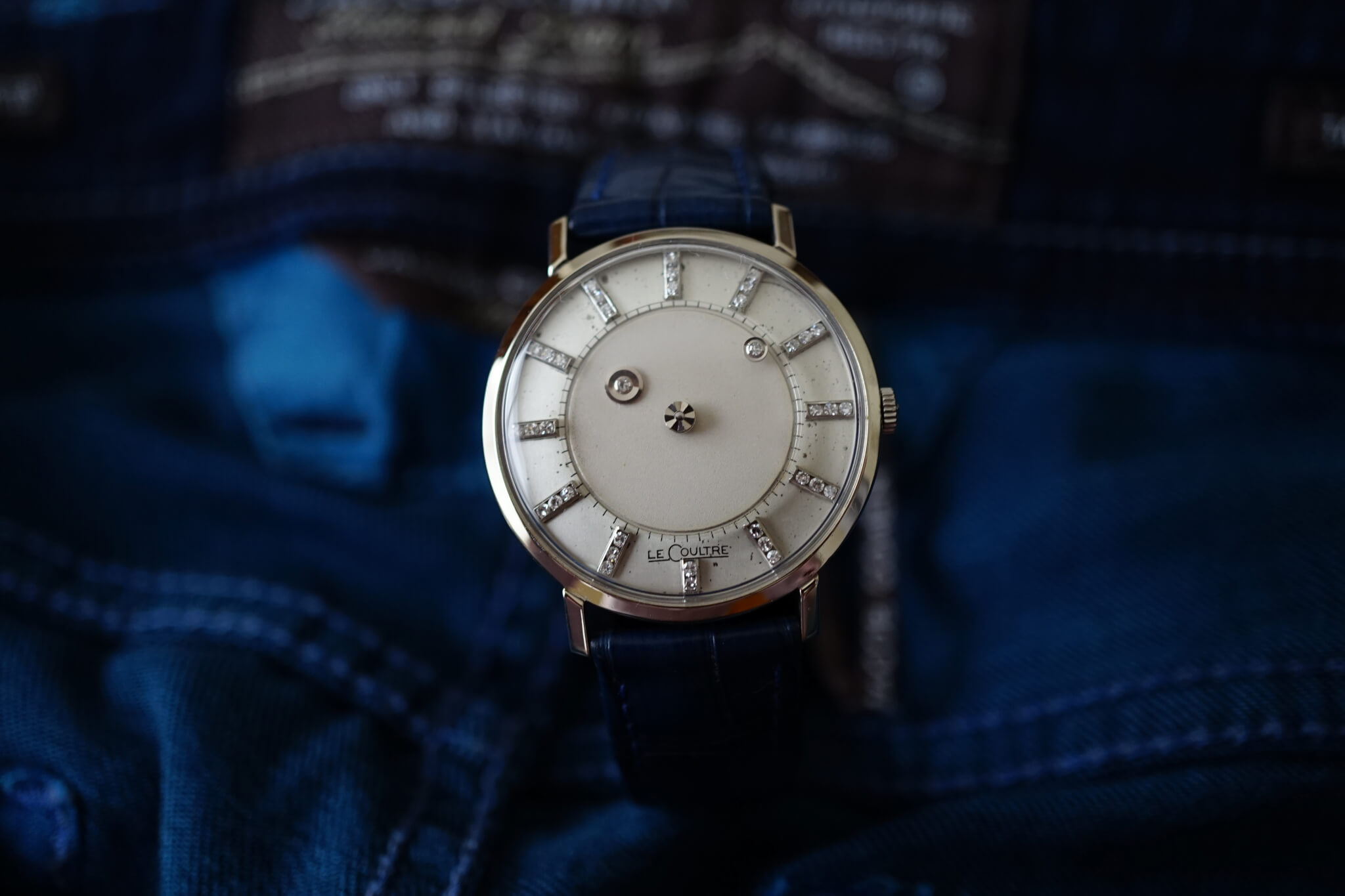
Vintage LeCoultre Galaxy (photo courtesy George Cramer)
That makes this watch the only model that is signed by both brands: the case is signed with Vacheron Constantin, while the dial is signed by LeCoultre. And the movement is a LeCoultre caliber.
The true reason why Vacheron Constantin’s name is on the case is probably best explained by the fact that by the time the Galaxy was introduced, both of these venerable Swiss companies had entered into an agreement created to aid the then-ailing Genevan giant.
“The solution did appear in 1938 with a bold association between two of the most prestigious watchmakers in the world,” Franco Cologni wrote in 2015’s Artists of Time, a magnificent retrospective of Vacheron Constantin’s history. “. . . SAPIC (Société Anonyme de Produits Industriels et Commerciaux), a joint company, was formed, comprising Vacheron Constantin, Jaeger-LeCoultre, and the latter’s various subsidiaries.”
This association combined the strengths and skills of both Vacheron Constantin and Jaeger-LeCoultre. In 1938, “Fundamentally reorganized, but stronger, Vacheron Constantin prepared to face the dramatic years ahead.” The two only separated again in 1965. “The two companies had been together for almost thirty years, and had produced some wonderful advances in the world of watchmaking,” Cologni continued. “But [Vacheron Constantin president] Ketterer wanted total freedom to create and manufacture. This meant that the company was on its own to face the great evolution just around the corner: the arrival of quartz, which would threaten Switzerland’s overwhelming domination of the horological world.”
This turn of events meant that both Jaeger-LeCoultre and Vacheron Constantin shared the same American subsidiary from 1938 through 1965. Perhaps the synergy of both brands’ combined signing of this watch was to offer customers an extra reason to purchase it. Not that the Galaxy needed further enticing: it is a very balanced and well executed design.
Its rather straightforward 14-karat white gold case set the stage for the real action here: the dial, offering small, white gold rectangles serving as hour markers, each of them featuring three brilliant-cut diamonds set inside the applied marker outline.
These diamond-filled markers form the outer perimeter of the dial at whose center turns a disk set with a single diamond inside a white gold chaton indicating the hours. Above this another disk made of transparent hesalite is positioned in which another diamond is set surrounded by a white gold chaton; this diamond indicates the minutes.
The brilliance of the design is that the diamonds actually seem to be suspended in air. The Swiss manufacture made the transparent disk exactly same size as the revolving center of the dial, so that when one looks at the watch the transparent disk it is virtually invisible. From the side an astute observer can see the disk, although to accomplish this the watch must be positioned at precisely the right angle since the cleverly formed crystal prevents observers from seeing it otherwise.
Jaeger-LeCoultre – LeCoultre was the brand name used in this period in the United States – was not the only brand to introduce diamond-set mystery watches. It had a strong competitor in Longines, who offered a watch with a little less mystery, but more diamonds.
Other interesting diamond-set watches for men
Longines achieved its myster by forgoing the transparent disk that Jaeger-LeCoultre used, simply utilizing a hand to indicate the minutes instead; the tip of this hand was set with a brilliant-cut diamond. To prevent the owner from seeing the tube connecting the hand to the movement, a diamond was also placed there.
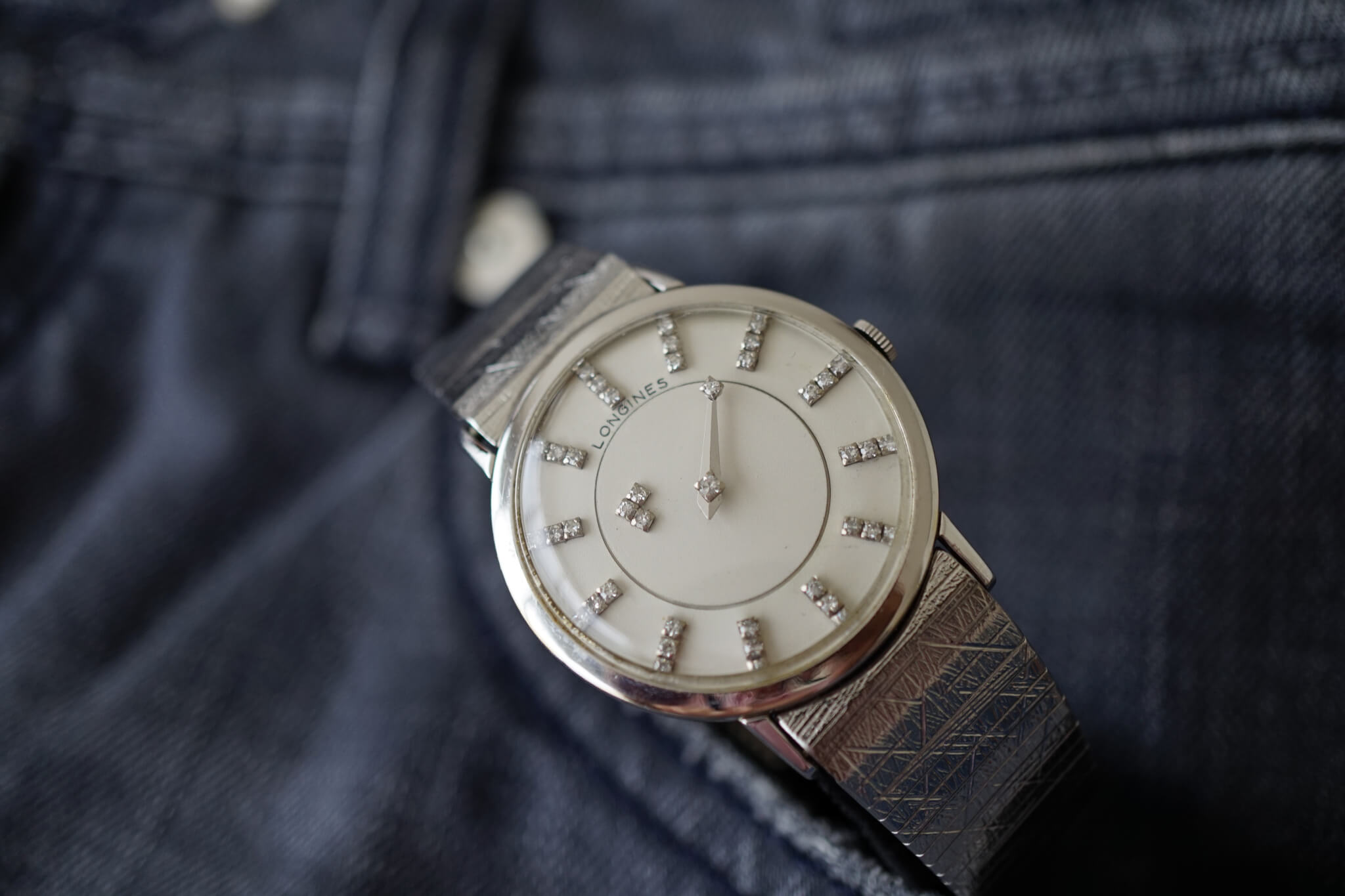
Vintage Longines Mystery watch, the hours are indicated by the three diamonds here at 10 o’clock (photo courtesy George Cramer)
The disk with the single diamond indicating the hours was constructed quite similarly to that found on the LeCoultre Galaxy. Both Longines and LeCoultre offered their mystery watches in white as well as yellow gold, with either a black or silver dial, available in various layouts and with different diamond configurations.
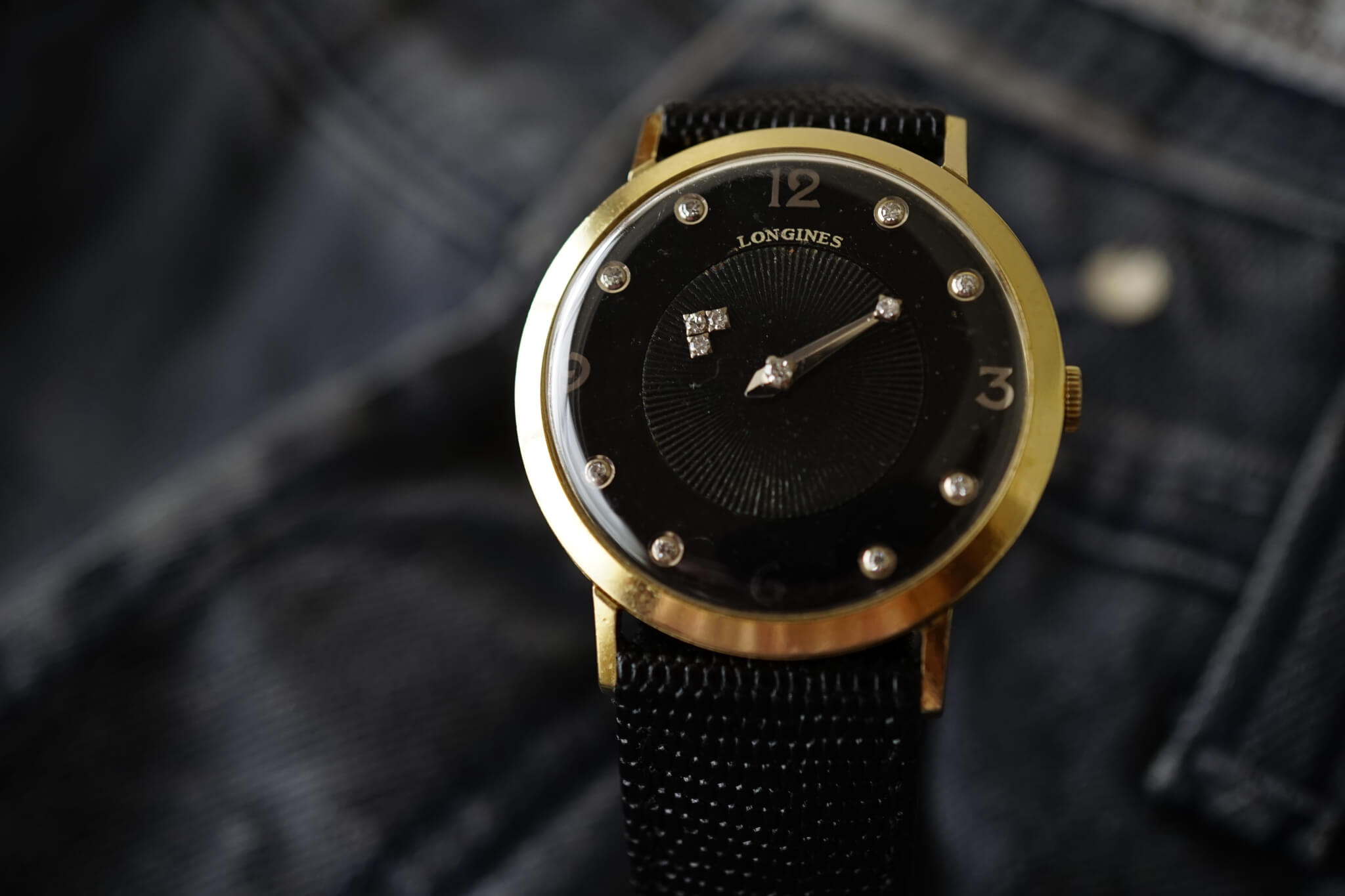
Vintage Longines Mystery watch with black dial (photo courtesy George Cramer)
This last aspect also plays into a certain hierarchy that exists among diamond-set watches: the stone count. In today’s market, a diamond-set watch is often only offered in a single configuration. But in the past, the brands used a single model to appeal to a wider variety of tastes and wallet sizes. They often started with the dial, where the amount of diamonds that replaced the hour markers increased in even increments.
Once those were fully set, they moved over to the bezel and in some cases even the lugs. This allowed people to acquire quality timepieces set with a few diamonds for a relatively modest surcharge, while the happy few could still set themselves apart with the same model with more and even many more diamonds.
Although sometimes part of a brand’s marketing approach, the stone count hardly ever triumphed over aesthetics. The diamonds on these watches were of course used because they happen to be special pieces of carbon that were lucky enough to be exposed to extreme pressures near the earth’s core, but their place on the watch had to be balanced in relation to its overall design.
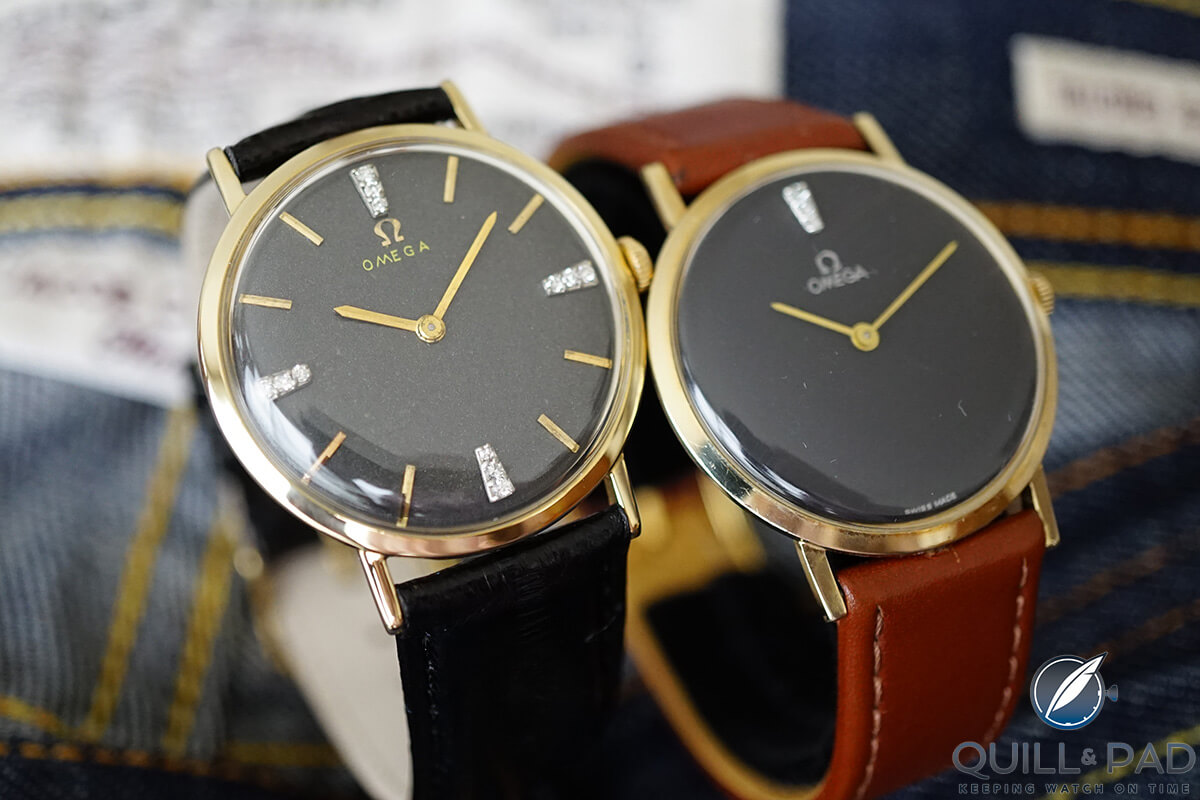
Vintage diamond-set Omegas in 14-karat yellow gold with black dials (photo courtesy George Cramer)
Omega needed just three of the sparklers to make a powerful impact with its diamond watch for men. A simple, round, yellow gold case featuring a matte black dial with a minimum of text was amplified by three brilliant-cut diamonds to mark the sun’s zenith at 12 o’clock. Simply elegant and an oh so effective use of diamonds.
14-karat gold as the standard
As was custom for gold timepieces in the U.S. market in those days, most diamond-set watches from this era were housed in 14-karat gold cases. Certainly 18-karat gold was available, but only the most exclusive diamond-set watches received a case crafted in this precious metal: watches thus encased were part of a universe all their own, a universe even beyond the reach of Don Draper and his contemporaries, who were considered nothing more than blue collar workers by those who easily could afford such watches.
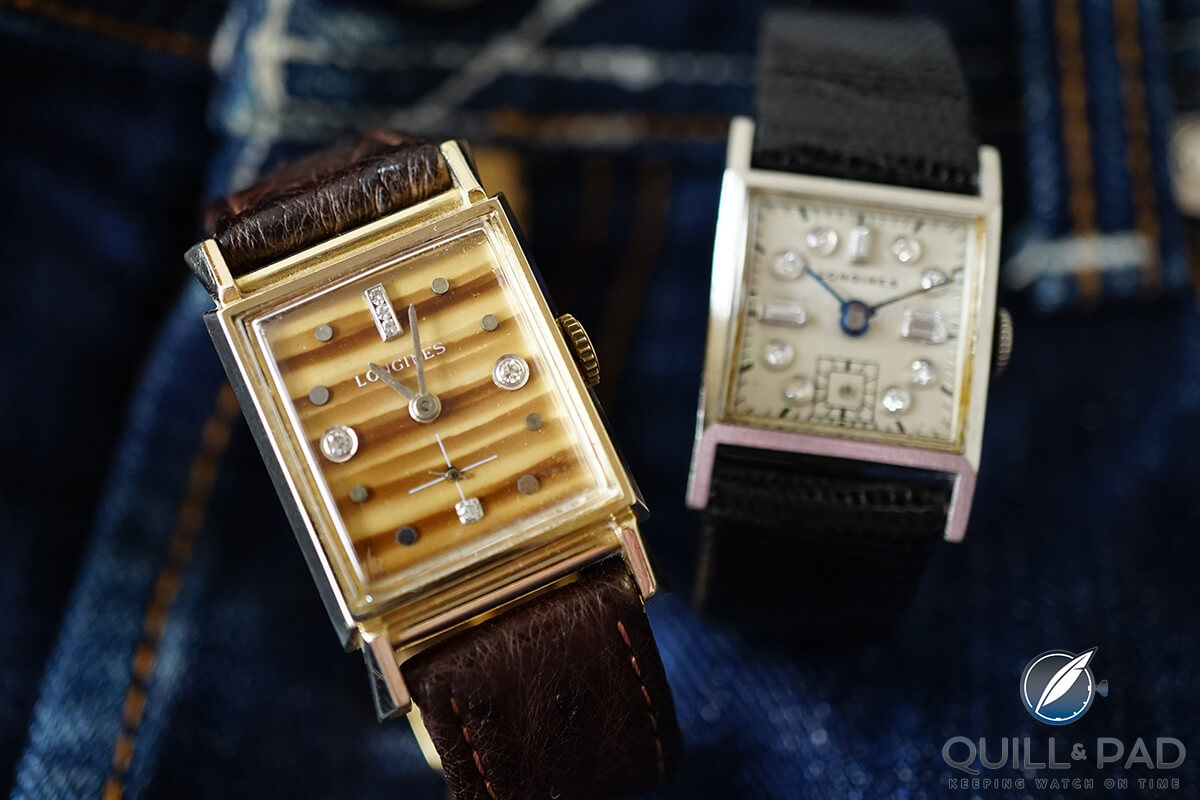
Two vintage diamond-set Longines models: the left in 14-karat gold with a tiger’s eye dial and the right in a rare palladium case (photo courtesy George Cramer)
The Longines Signet is an example of such a watch. Although not one diamond is seen on the dial, the case – including the lugs – feature a setting of brilliant-cut, colorless diamonds. Inside the case Longines’ refined, hand-chamfered manufacture Caliber 9LT keeps track of the time.
A watch like this – offering a level of refinement that ranks it among the top manufactures of its day – suffered greatly from the Longines brand’s repositioning after the Quartz Crisis.
Another brand that finds itself in a similar situation is Hamilton.
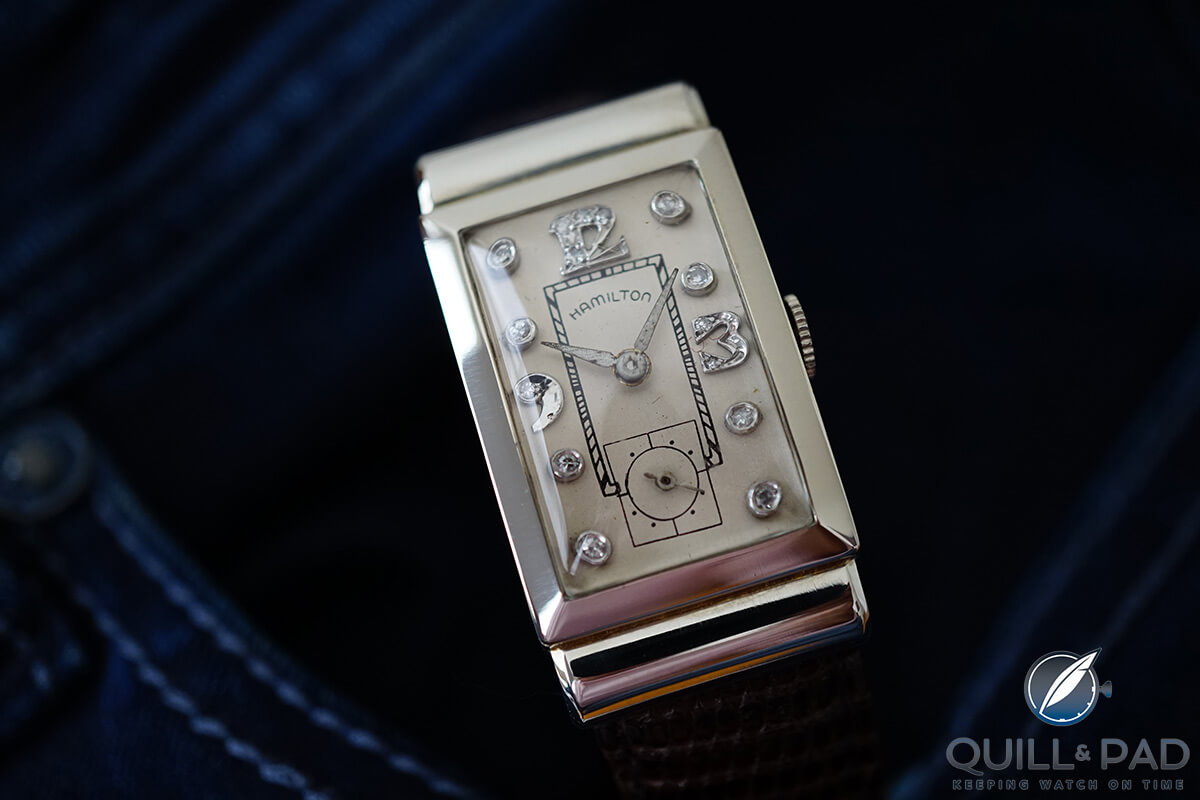
Diamond-set vintage Hamilton in a 14-karat gold case (photo courtesy George Cramer)
With an extensive catalogue of diamond-set men’s watches – again paired with fine mechanical manufacture calibers – Hamilton was a force to be reckoned with in the North American market. Where most Swiss-based competitors still mainly opted for round cases, Hamilton made it a point to offer its highly regarded shaped watches also in diamond-set versions. Since Hamilton already catered to the specific North American taste of those days, its diamond-set watches were quite successful.
Hamilton was not the only American brand that was successful with diamonds for men.
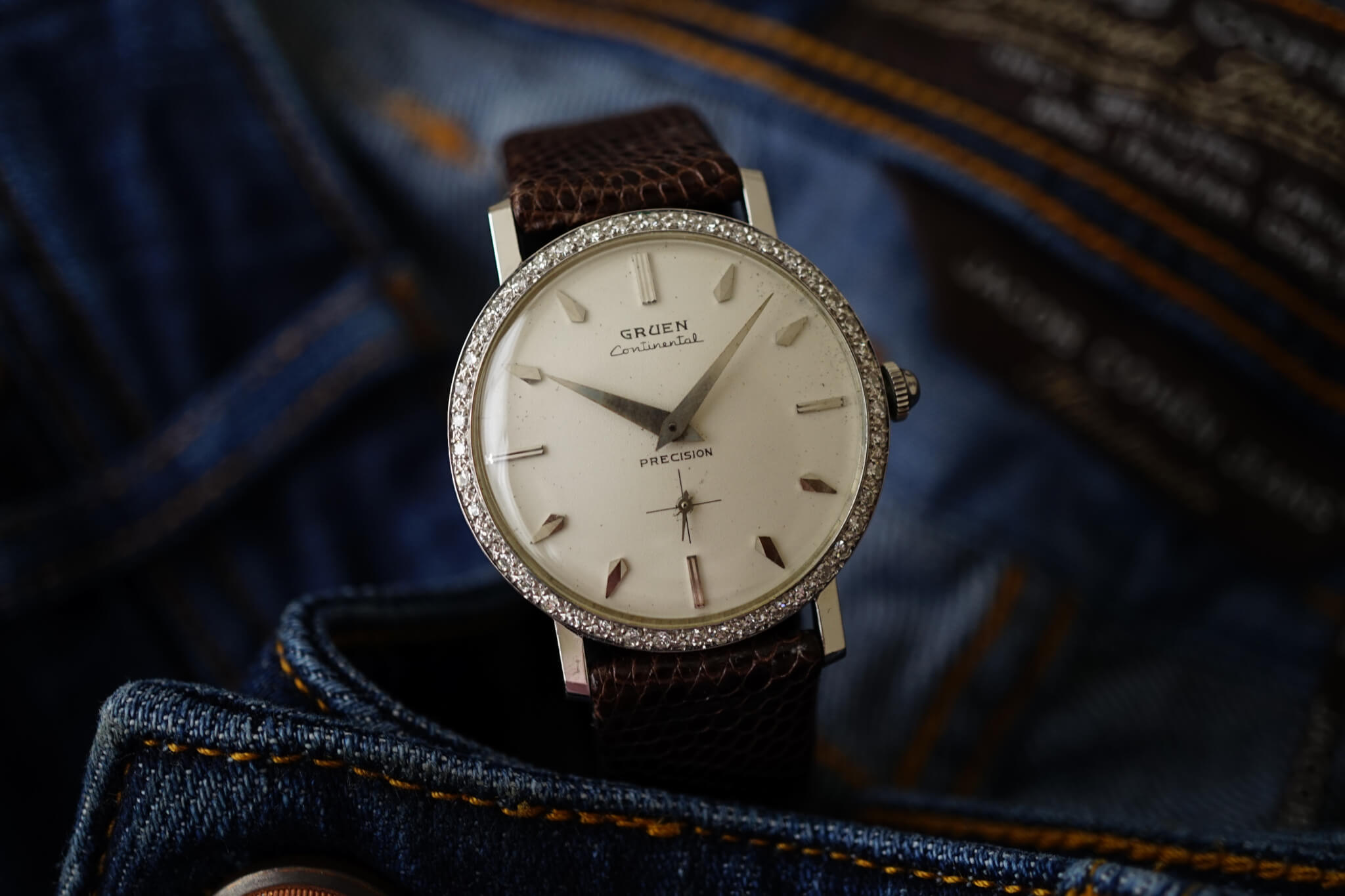
Vintage Gruen Continental with diamond-set bezel (photo courtesy George Cramer)
Gruen is an often overlooked American brand in vintage circles as it seems to stand in a constant shadow cast by better known names such as Bulova and Hamilton, which originates in more recent developments than the status the brand enjoyed when it was in the prime of its existence.
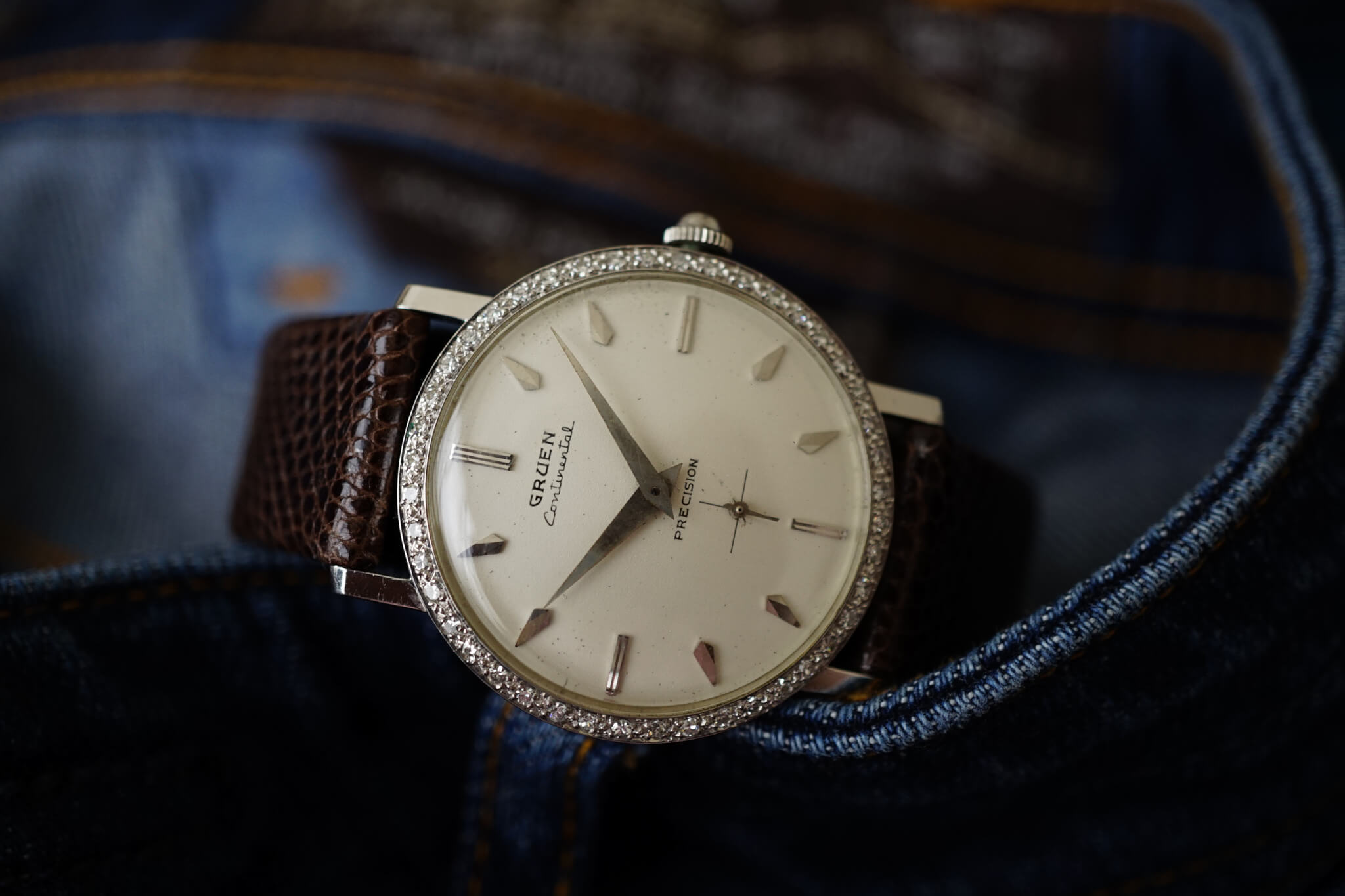
Gruen Continental (photo courtesy George Cramer)
Gruen has a fascinating history, from using the same movements Aegler made for the Rolex Prince in the 1920s to the creation of the stunning Curvex. Lesser known models, like the diamond-set Continental, are best appreciated when one actually holds the real thing in one’s own hands. The elegance of the font, the overall slim profile, and the refined details of the case and hour markers are bound to please any vintage watch connoisseur.
Details are what separate the wheat from the chaff
Details are often also where these diamond-set watches show their true characters, a character that goes much deeper than simply being a gold watch set with diamonds.
Take for example a lovely square Longines that is fitted with a triangular shaped crystal of almost the same height as the case. One might wonder why Longines would do this? Well, the highest point of the crystal is right above the two baguette-cut diamonds placed as hour indices at 3 and 9 o’clock, creating the optical illusion that they are twice their actual size.
Omega also worked with optical illusions, though with a slightly different approach. The brand created men’s watches with small, manually winding movements in them that were normally reserved for its ladies’ watches.
This allowed Omega to only have a center part of the watch case to provide the required thickness to house the movement. On its outer rims the gold case quickly and smoothly curved up to meet the bezel. When strapped on, the thickest part of the watch was pushed slightly into the skin, and the illusion of an ultra-thin watch was created.
These are just a few small examples of the ingenuity that their makers put into these elegant watches.
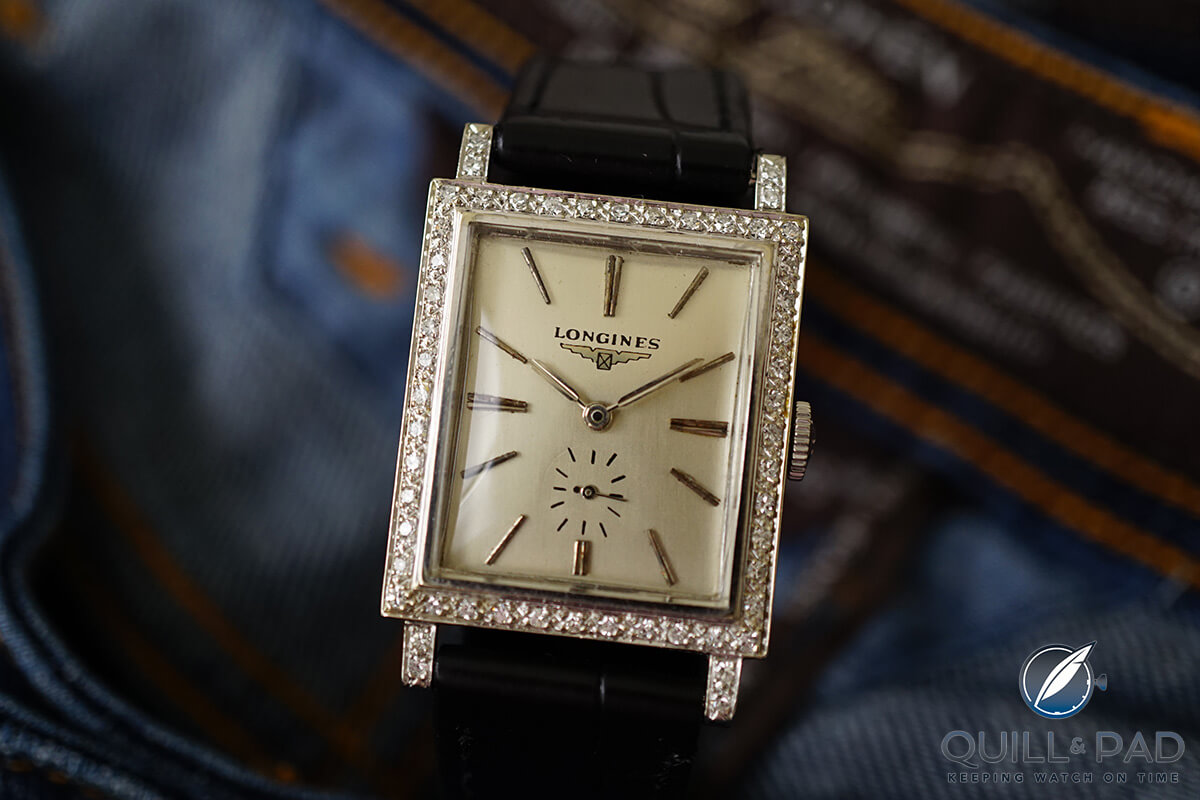
Vintage Longines Signet in an 18-karat gold case with diamond-set bezel (photo courtesy George Cramer)
But time moves on
The era of diamond-set men’s watches had already significantly slowed down just before the Quartz Crisis. In the late 1960s and early 1970s, watches had become larger and thicker and far more colorful. None of these elements went particularly well with diamonds.
Society had changed, taste had changed, and, with the big bang that was the Quartz Crisis, the watch industry had changed.
Today, many of the diamond-set watches from that era have experienced the same fate as that of the American subsidiaries of Swiss brands: some have vanished, others have been scrapped for the value of their diamonds and gold, and the survivors just survived – more often than not, on the appreciative wrist of a woman.
Very few survivors still enjoy the lifestyle they were once created for on the wrist of man who has accomplished something, treating himself to a watch crafted with precious diamonds and gold.
Quick Facts LeCoultre/Vacheron Constantin Galaxy
Case: 33 mm, yellow gold or white gold
Dial: available in black or white, set with 35 diamonds in the markers and two as hands (37 total)
Movement: manual winding LeCoultre Caliber 480
Functions: hours, minutes
Original price in 1957: $325
Last known price: $6,875 at a 2012 Christie’s auction
Trackbacks & Pingbacks
-
[…] The cultural perspective also plays an important role: where in one market diamond setting instantly and indisputably makes a timepiece for a woman (or a faux pas for a man), in another market it can indicate a male being very successful at what he does for a living (see How, When, And Why Diamond-Set Watches For Men Were Commonly Accepted And The Importance America Pla…). […]
Leave a Reply
Want to join the discussion?Feel free to contribute!



This is a great piece of writing, Martin! Truly awesome product shots and eloquent copy. Thank you!
Thank you for your kind words!
This is just wonderful reading. I have been fascinated by watches since I could crawl. Now that I am old enough to walk, I am enjoying the ability to acquire vintage timepieces.There is one in particular that I absolutely love, a 1960’s hidden dial, diamond encrusted, bracelet watch by Patek. The very few I have found advertised for sale, are being sold as “womens”. It really doesnt bother me, for I do not look at it as masculine or feminine, just a thing of beauty, that was right for the times (pardon the pun). I have some women friends who wear very masculine Rolex watches. They do so because they like the look and feel of them. It should be reciprocal, in the battle of the sexes.